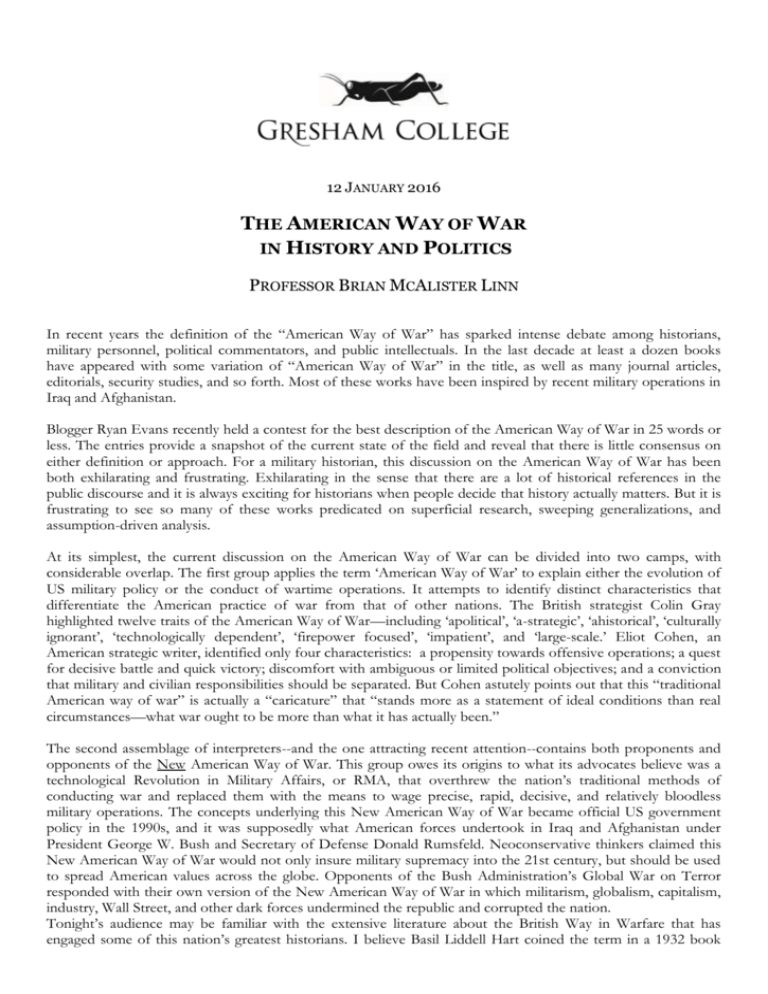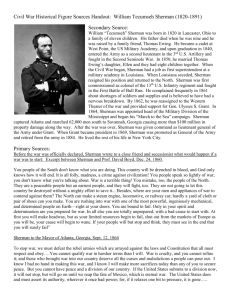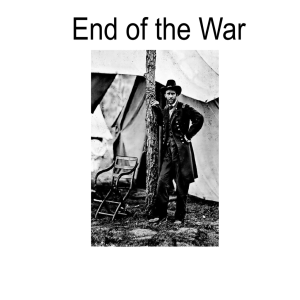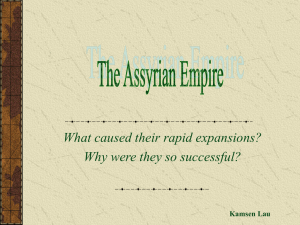The American Way of War in History and Politics
advertisement

12 JANUARY 2016 THE AMERICAN WAY OF WAR IN HISTORY AND POLITICS PROFESSOR BRIAN MCALISTER LINN In recent years the definition of the “American Way of War” has sparked intense debate among historians, military personnel, political commentators, and public intellectuals. In the last decade at least a dozen books have appeared with some variation of “American Way of War” in the title, as well as many journal articles, editorials, security studies, and so forth. Most of these works have been inspired by recent military operations in Iraq and Afghanistan. Blogger Ryan Evans recently held a contest for the best description of the American Way of War in 25 words or less. The entries provide a snapshot of the current state of the field and reveal that there is little consensus on either definition or approach. For a military historian, this discussion on the American Way of War has been both exhilarating and frustrating. Exhilarating in the sense that there are a lot of historical references in the public discourse and it is always exciting for historians when people decide that history actually matters. But it is frustrating to see so many of these works predicated on superficial research, sweeping generalizations, and assumption-driven analysis. At its simplest, the current discussion on the American Way of War can be divided into two camps, with considerable overlap. The first group applies the term ‘American Way of War’ to explain either the evolution of US military policy or the conduct of wartime operations. It attempts to identify distinct characteristics that differentiate the American practice of war from that of other nations. The British strategist Colin Gray highlighted twelve traits of the American Way of War—including ‘apolitical’, ‘a-strategic’, ‘ahistorical’, ‘culturally ignorant’, ‘technologically dependent’, ‘firepower focused’, ‘impatient’, and ‘large-scale.’ Eliot Cohen, an American strategic writer, identified only four characteristics: a propensity towards offensive operations; a quest for decisive battle and quick victory; discomfort with ambiguous or limited political objectives; and a conviction that military and civilian responsibilities should be separated. But Cohen astutely points out that this “traditional American way of war” is actually a “caricature” that “stands more as a statement of ideal conditions than real circumstances—what war ought to be more than what it has actually been.” The second assemblage of interpreters--and the one attracting recent attention--contains both proponents and opponents of the New American Way of War. This group owes its origins to what its advocates believe was a technological Revolution in Military Affairs, or RMA, that overthrew the nation’s traditional methods of conducting war and replaced them with the means to wage precise, rapid, decisive, and relatively bloodless military operations. The concepts underlying this New American Way of War became official US government policy in the 1990s, and it was supposedly what American forces undertook in Iraq and Afghanistan under President George W. Bush and Secretary of Defense Donald Rumsfeld. Neoconservative thinkers claimed this New American Way of War would not only insure military supremacy into the 21st century, but should be used to spread American values across the globe. Opponents of the Bush Administration’s Global War on Terror responded with their own version of the New American Way of War in which militarism, globalism, capitalism, industry, Wall Street, and other dark forces undermined the republic and corrupted the nation. Tonight’s audience may be familiar with the extensive literature about the British Way in Warfare that has engaged some of this nation’s greatest historians. I believe Basil Liddell Hart coined the term in a 1932 book that contrasted a purported historic and successful British strategy of maritime global economic warfare with the disastrous continental commitment in 1914. As Sir Michael Howard noted, Hart’s analysis was less history than an effort to shape foreign and military policy in the 1930s. For most American historians, the term “American Way of War” was delineated in 1973 by Professor Russell Weigley’s book of the same name. Although the title stated it was a study of American military strategy and policy, Weigley defined a ‘way of war’ rather narrowly as the conduct of wartime military operations. In common with several other historians, Weigley believed the American Civil War of 1861 to 1865 marked a revolutionary break with the nation’s traditional military methods. In its War of Independence, American generals had sought to wear down their opponents until the British government concluded that victory would come at too high a cost. Later American generals had sought limited political and military goals, waging war much in the European tradition. But in the Civil War these traditional methods failed, and the Union shifted to a strategy of annihilation, seeking to overthrow the Confederate armed forces and destroy the enemy state. This new strategy was manifest in the campaigns of Ulysses S. Grant and William T. Sherman and continued with even more destructive results in the Second World War and in Vietnam. Unfortunately, both the catchiness of Weigley’s title and the apparent simplicity of his thesis led to it quickly becoming a “caricature.” Few people outside of the historical community were willing to read a 500-page book and appreciate its nuances, or its many contradictions. Instead, they seized upon Weigley’s rather vague use of the term “annihilation” and his argument that the Civil War marked a radical turning point in American strategy. And in the hands of analysts less sophisticated than Weigley, it is a short step from Sherman’s campaigns in Georgia to the atomic bombing of Hiroshima, to “search and destroy” in Vietnam, and to the recent operations in Iraq and Afghanistan. But did the Civil War really mark the birth of that always confusing term “American exceptionalism”? Was this conflict a turning point from which emerged a distinct national way of war? The evidence is not conclusive. Indeed, the argument for a Civil War-inspired revolution in American military affairs can only be sustained by ignoring a great deal of contradictory evidence. To begin with, many Civil War historians maintain that Sherman’s actions in Georgia and South Carolina were what the British might term a “one off”, the most untypical of American campaigns in the most untypical of American wars. In their view, Sherman’s policies were the result of strategic improvisation dictated by specific circumstances, not by the embrace of a radically new method of waging war. The argument becomes even more difficult to sustain if we try to establish a propensity for annihilation after the Civil War. The Spanish-American War, fought in 1898, waged by the very generals who had supposedly learned ‘annihilation strategy’ under Grant and Sherman, was throughout a limited war in its strategy and objectives. American troops in the Philippines behaved brutally, but they never sought to annihilate the Filipino populace and most of their actions were within the existing laws of war. President Woodrow Wilson might have fulminated that the Great War was the war to end all wars, but in practice the American military forces in France in 1918 fought a conventional battle of attrition much like the Allies, if with far less skill. And when General John Pershing suggested that the war continue until the German army acknowledged defeat and Allied troops were in Germany, the president quickly stepped in, chastised Pershing for interfering in political decisions, and accepted the armistice. In the early 1950s, Douglas MacArthur entertained visions of annihilating communism in Asia, but neither his political bosses nor the general who replaced him agreed. They insisted that Korea was a limited war and sought a negotiated armistice based on status quo ante bellum. And as Weigley himself admitted, Vietnam was really a war of attrition with very limited, if unachievable, political and military objectives. In short, the argument that the Civil War shifted American strategy from attrition to annihilation requires not only a gigantic leap from 1864 to 1944, but also disregarding all the intervening wars and most of those that followed. Some might claim that Sherman’s ghost can be seen less in national strategy or the conduct of military operations than in his intellectual legacy. The argument is that Sherman bequeathed to future American military leaders a tendency to envision war as total, and thus justify the terrorization of the populace. But this argument is also difficult to sustain. We know that at times he spoke of making “all Georgia howl” and that “war is hell.” 2 But it is important not to take these comments out of context, but rather as part of the very large corpus of Sherman’s writings on war. There is much evidence that Sherman’s strategic views were governed by the military engineering curriculum that he, and many other Civil War generals, absorbed as a cadet at the US Military Academy in the 1840s. Canadian historian Ian Hope’s recent study situates the general firmly in the US Army’s scientific approach to warfare. Hope argues Sherman’s objective was not to terrorize the Southern population— though he certainly recognized that he was undermining their morale—but preventing the main Confederate army from using the Carolinas for supplies or as a base of operations. Nor is there strong evidence that his wartime experience changed the way that Sherman or his fellow officers regarded the conduct of war. A decade after the end of the Civil War, Sherman’s recommendations for textbooks for the US Army’s postgraduate school was British authors Francis James Soady and Edward Hamley—both of whom shared Sherman’s own scientific approach to war. Nor is there evidence that other military officers used Sherman to justify a strategy of terrorizing civilians. The US Army intellectuals who wrote in the decades after the Civil War were more interested in contemporary European campaigns, and this provided a major portion of the curriculum at the Army schools. When students did study the Civil War, they focused on the conventional military operations in the Eastern Theater, not on Sherman. Finally, there is little documentary evidence that in the 80 years between the Civil War and the Second Word War American military thought was heavily influenced by Sherman’s campaigns. So if we are going to blame anyone for the revival of Sherman as the archetype of Civil War leadership, we must blame the British, and particularly Basil Liddell Hart, who in the 1930s portrayed Sherman as a master of both maneuver and the indirect approach, but who downplayed the impact of his operations on noncombatants. However, if Sherman’s campaigns cannot be shown to mark a revolutionary turning point in the US Army’s “way of war,” they may yet have done so in the realm of maritime warfare. At the end of his march through Georgia, Sherman explained his scientific approach to warfare to a US Navy officer, Stephen B. Luce. Luce was so impressed he decided that maritime operations required an equally intellectual foundation. Some years later, Luce appointed Alfred Thayer Mahan to provide one, and Mahan found his inspiration in the maritime campaigns of the Royal Navy against the French. This, in turn, helped prompt Julian Corbett’s work on limited warfare, which in turn shaped Liddell Hart’s view of national strategy. In short, one might make a better argument that Sherman is the intellectual father of the British Way in Warfare rather than a particularly destructive American Way of War. If we cannot prove that the Civil War marked a distinct turning point in the American Way of War, perhaps other conflicts sent US military strategy and policy on a distinct trajectory. Some scholars have found in the very nature of frontier fighting a predisposition for Americans to target civilian populations. Other historians have maintained it was World War 2, and particularly the strategic bombing campaign, that changed the American viewpoint on warfare. As with the Civil War thesis, these provocative interpretations are sometimes weakened by sweeping conclusions on the entirety of American history based on historical expertise in a specific area. Few historians have attempted Weigley’s effort to identify a distinct American Way of War emerging from over two centuries of campaigns and operations. One worthy successor, Antulio Echevarria, concluded that in practice the American Way of War has been characterized by extensive political constraints—seldom have US generals been allowed to wage war as they wished. Echevarria dismissed arguments that any one war, particularly the Civil War, established a distinct pattern that was henceforth followed by American military leaders. Instead, he found American military leaders have most consistently followed a strategy of expediency. Although they may have wished to annihilate the enemy quickly—what general does not—they usually recognized this was impossible. Echevarria also argues that, contrary to both the Weiglians and the US armed forces’ own claims, the American military have seldom employed overwhelming and decisive force to achieve victory. The only constant in the American Way of War Echevarria identifies is the belief that tactical success will create strategic success, which, as he notes, makes it indistinguishable from the European Way of War. Another approach, very popular with the armed forces, is to define the American Way of War as a redemption narrative. This was the view of Emory Upton, whose unfinished 1881 manuscript, The Military Policy of the United States, continues to exert a strong influence on the writing of military history. In this cyclical narrative, Upton maintained that during peacetime American citizens refused to listen to the wise and impartial counsel of their 3 military leaders. They reduced their armed forces to skeleton organizations while boasting of their native-born martial skills. When war came, the public demanded immediate action--with the result that better trained and disciplined enemy armies quickly defeated America’s citizen-soldiers. Only when the nation faced disaster did it turn the conduct of war over to its professional soldiers, submit to military training, and eventually win after wasting much unnecessary blood and money. After victory, the nation promptly dismantled its armies, extolled the accomplishments of its natural civilian warriors, and began the cycle again. Closely related to the Uptonian definition of a Way of War is that of the ‘prodigal soldiers’ who, despite the disinterest of their political masters and the American public, resolutely prepare for war and are ultimately vindicated when it appears. This is an especially popular narrative in the post-Vietnam War literature. A final approach is to look at the American Way of War less as the practice of war than as how American military officers have conceptualized or envisioned war. This would require us to define a “way of war” as a distillation of the intellectual output of military officers on how they interpreted past conflicts, how they perceived the current military situation, and how they envisioned the future. There are some who argue that at certain times Americans have undergone a military paradigm shift, replacing one construct of war with another. This argument appears in biographies of such individuals as Alfred Thayer Mahan in naval thought, or Billy Mitchell, John Boyd, and John Warden in airpower, or most recently, David Petraeus in counterinsurgency. There is also an extensive literature that might be termed ‘generational biography’ that credits the accomplishments of a particular group—such as the post-Vietnam officer corps—in transforming the American Way of War. But to explore how American military officers have conceptualized warfare requires the long view of perhaps a century, and referencing not only the writings of a few prominent individuals, but the entire corpus—books, articles, war plans, general staff studies, doctrine, student papers, and so forth. Seen from this broader context, a study of the US Army dating back to the 1820s reveals that military intellectuals have remained remarkably consistent in their overall concept of war. That is, they have been remarkably consistent to one of three viewpoints. Some view war as a form of engineering or science in which the correct application of principles by professional elites will result in a predictable outcome. This was the vision taught to aspiring officers at the US Military Academy for over a century, the one embraced by Sherman, and still manifested in the 1990s Powell Doctrine that created a set of rules to govern the deployment of military forces overseas. But other military intellectuals have long believed in a heroic vision. To them, war is a struggle between nations and cultures in which victory goes to the side displaying the most martial virtues—patriotism, discipline, leadership, morale, and so forth. They often ascribe to specific individuals great powers to transform the conduct of war and impose a paradigm shift on their organizations. The dominant school in the US Army is a third group, the Managers, who envision war as a complex project requiring the coordination of military, political, marketing, economic, and social resources. All three schools of thought co-exist within the US Army intellectual community. Each will interpret the lessons of recent conflicts according to the precepts of the school, whether it is a counterinsurgency struggle in the Philippines or the Second World War. Engineers, for example, are already interpreting the wars in Iraq and Afghanistan as a violation of the Powell Doctrine, while Warriors blame politicians and American society. In contrast to much of the literature based on individuals or specific conflicts, a study of the American armed forces’ collective writings finds r little change in the military’s conceptualization of war. In the late 1980s, the term American Way of War took on more than historical interest when it began to be employed by a diverse group that included military authors, civilians in the international relations and security studies communities, journalists, and public intellectuals. Much of their interest was fueled by a belief that emerging technologies such as precision guided munitions, stealth aircraft, computers, and satellite communications provided the means for a Revolution in Military Affairs, or RMA. Used effectively, such technology could not just ‘offset’ the Soviet superiority in manpower and materiel in Europe, but also insure that such a conflict did not escalate into nuclear holocaust. Initially much of the enthusiasm for the RMA came from critics of American defense policy. These reformers claimed the US was investing in upgrading traditional weapons systems—tanks, artillery, bombers—in order to wage a conventional slugging war of attrition. What was needed, they argued, were technologies that enabled smaller, lighter, more agile forces to defeat Soviet masses. The reformers dismissed the “old” or “traditional” American Way of War as methodical, conservative, 4 attritional, bloated, bureaucratic, overly centralized, cumbersome, and conservative. They asserted that a study of the past showed the nation’s military leaders had relied on unimaginative, brute-force tactics and overwhelming resources to grind down and destroy opponents. Against this they contrasted the possibility of a rapid, decisive, and cheap “New American Way of War.” They claimed that technology could remove the “fog of war,” eliminate much of the friction that Clausewitz had identified as inherent to armed conflict, and allow commanders and troops to move unerringly forward to target and destroy the enemy. Both conservatives and reformers found vindication in the perceived lessons of the Persian Gulf War of 1991. To the American armed forces it justified their procurement programs, training, and leadership. To the reformers, it proved that new technology provided an insurmountable advantage. The US Air Force took the lead by claiming credit not only for its success in the Gulf War but also for creating a radically new way of war. What came to be known as “Effects Based Operations” postulated that information superiority provided precise targeting of crucial ‘centers of gravity’ at all levels—strategic, operational, and tactical—whose destruction would trigger military collapse. Information superiority would also deny the enemy government the ability to control its citizens and its armed forces. A few well-placed bombs could destroy the opposition’s communications and isolate, or even kill its leadership. Without any directing brain, armed resistance would be sporadic, uncoordinated, and too slow to respond to American strikes. The slide “Precision Redefines the Concept of Mass” is perhaps more revealing than its US Air Force publicists intended. It illustrates a sterile, surgical, managerial vision of conflict. The Air Force intends to wage a war by using a mathematical formula to calibrate, with scientific precision, how just 16 bombs dropped in 2004 can achieve the cumulative strategic impact of 9,000 bombs in 1944. What the formula provided these equations? More insidiously, this slide implies a contract with the political leadership and the American public that the Air Force can fight and win wars with minimal expense, time, or trouble. The US Navy was meanwhile developing its own concept of future war, termed Network Centric Warfare. Like the Air Force, Navy theorists were fascinated by the possibilities of the ‘information age’ and the vision of forces dispersed across the globe concentrating their military power to quickly overwhelm opposition. Its proponents argued that new technology provided a “transparent battlefield” in which information could flow instantly between the commander and his tactical units, and in which the enemy’s positions and movements would be instantly identified and targeted. Although Navy and Air Force advocates disagreed on which service should be predominant, both Effects Based Operations and Network Centric Warfare shared essentially the same vision of scientific warfare in which American military forces were so ‘super empowered’ that the enemy was virtually powerless. From the beginning, the attraction of the New American Way of War was in part ideological. The military reformers claimed the United States was in danger, and if it failed to grasp the opportunities offered by the Information Revolution, its enemies would not. They warned that history revealed numerous examples of great nations brought to ruin by more adaptive opponents. One particular historical comparison was made over and over. Americans must either embrace the blitzkrieg or the Maginot Line. This became such a commonplace that at the Army War College in 2001, I heard one student remark that if he was ever in France in 1940 and saw a German tank he now knew exactly what to do. But as Thomas Barnett’s declaration, written at the height of the Bush Era’s military adventurism makes clear, its proponents redefined the American Way of War in nakedly ideological terms—as a means to execute their blueprint for United States global hegemony. In 1996, much of the reformers’ agenda was codified in the United States’ Department of Defense’s Vision 2010. As this slide from the Vision 2010 brochure illustrates, “information superiority” and “technological innovations” would generate four ‘effects’: dominant maneuver, precision engagement, focused logistics, and full-dimensional protection --which cumulatively result in “massed effects”—illustrated by American air, naval, and land forces converging on a squad of enemy tanks obligingly parked in the desert. This next slide shows how information superiority and new technologies allow American forces to engage in “dominant maneuver.” From a headquarters back in the United States or some other safe place, information is instantly collected, evaluated, and then disseminated to all the various combatant units, which converge quickly to seize positional advantage at such a high rate of tempo that the enemy is paralyzed. This leads to “asymmetric 5 leverage” and the overturning of the enemy’s strategy. And, once again, the enemy is portrayed in Gulf War terms as a mechanized force isolated in the desert. There are no civilians, hospitals, schools, or other nuisances to hinder the full application of American firepower. At its simplest, Vision 2010 articulated a view that warfare is largely a managerial process in which the primary strategic problem is the identification and destruction of targets. As this slide on “Precision Engagement” shows, Vision 2010 and the prophets of the New American Way of War defined “military effects” in only the most immediate tactical terms. They did not discuss, or even mention, the effect of destroying military forces and government control in one-party dictatorships or tribal coalitions. But these were the very “failed states” predicted by the United States’ national security strategy as the most likely places for American forces to be deployed. Nor did they foresee the consequence of creating an American military force structure organized, equipped, and trained exclusively for quick, precise wars. For all their claims that they alone understood the nature of modern warfare, they failed to appreciate that if the New American Way of War failed to achieve a rapid decision, the result would be an indecisive, costly war of attrition. Vision 2010 became the basis for service ‘transformation’ plans. For the Navy and Air Force, it was largely seen as confirming existing ideas and procurement plans. But for the US Army, Vision 2010 launched the effort to scrap the Cold War arsenal and create an entire new armory with all the firepower and protection of mechanized forces and all the mobility of light forces. This produced a procurement plan, called the Future Combat System, and a “Transformation Plan.” The Future Combat System was, in the words of the Chief of Staff, a system of systems ranging from the infantry soldier to “unattended munitions.” The Transformation Plan outlined in extensive, if not excruciating detail a series of simultaneous initiatives that ranged from telling the Army’s story to articulating the strategic rationale for future capabilities. All initiatives were equally important and not only reinforced each other but would prove equally beneficial. In my view, this transformation plan illustrates two points worth noting about the New American Way of War. First of all, marketing was in many ways more important than strategy. Second, the Transformation Plan conformed to the New American Way of War’s ‘one-size-fits-all’ vision of the future battlefield. There was no appreciation that the US Army might be called on for nation building, counterinsurgency, or humanitarian interventions. Donald Rumsfeld, who became Secretary of Defense in 2001, embraced the New American Way of War with a fervor that shocked even some of its supporters. In what some described as a “hostile takeover” he waged an all-out offensive against military leaders he viewed as too set in the patterns of the past. His 2002 article in Foreign Affairs, written shortly after the Afghanistan invasion, hailed this operation as “a revolution in military affairs” that proved his “transformation” program was both necessary and working. He also identified the lessons of the Afghanistan war as showing the need for seamless communications, accepting allied assistance, defending the United States by preventative attack, and—perhaps most important—telling the truth to the American people. Both the promise and the flaws of the New American Way of War became apparent during the Bush Administration’s self-proclaimed Global War on Terror (or GWOT), together with the use of such controversial methods as drones, assassinations, human rights abuses, the imprisonment of suspected terrorists at Guantanamo, and so forth. In the initial flush of rapid victories in both Afghanistan and Iraq, culminating in the capture of the capital cities and the destruction of conventional military forces, right wing commentators proclaimed the dawning of a new age of national greatness implemented and enforced by the New American Way of War. In a 2003 article, Thomas Barnett outlined “100 Rules for the New American Way of War” that included the right of preventative warfare, the preservation of the global economic system, and a virtual blank check for American military interventions. Max Boot’s article, “The New American Way of War,” praised Secretary of Defense Rumsfeld for dragging the US armed forces into the 21st century and declared that the conquest of Iraq “must rank as one of the signal achievements in military history,” comparing favorably to the “gold standard” of the German’s 1940 blitzkrieg. When the occupations quickly turned into insurgencies or civil wars, some of these same writers shifted into the camp of General David Petraeus, whom they praised as an anti-Rumsfeld “insurgent” whose counterinsurgency strategy was yet another transformation of the American Way of War. 6 The triumphalist chest beating of both the Bush Administration and its supporters over Iraq and Afghanistan soon collapsed, and some former acolytes morphed into harsh critics. For the most part, their primary complaints were the military’s failure to fully actualize their vision of war and their increasing dissatisfaction with the alleged beneficiaries of American intervention—the Iraqis and the Afghans. Perhaps the most interesting critique has come from conservative commentator Andrew Bacevich. He identified a fundamental disconnect between the political and military leaders that created a vacuum in which tactical excellence and imperialist ideology, not strategy, dictated American military adventurism. In contrast, much of the leftist critique is derivative in both its tone and assumptions, even to having Vietnamera public intellectuals such as Howard Zinn and Noam Chomsky reviving their decades-old criticism of the dangers of American imperialism, capitalism, and so forth. Very few of these writers displayed even a fundamental appreciation of military realities, national strategy, or the armed forces. Their message was to the already converted, not to the rational, informed reader. At its worst, it consisted of little more than incoherent ranting. The index entry for “American Way of War” in Tom Englehardt’s The American Way of War includes “conceptually unending”; “Victim Discourse”; and “as a Hollywood movie.” But Englehardt never explains what he means by an American Way of War. Thus on both the left and the right the politicized dialogue on the New American Way of War resulted in very little of substance. What is the state of the debate at present? Despite the generally pessimistic tone of this lecture, there are some grounds for optimism. The recent Army Operational Concept rejects much of the scientific way of war that appeared in Vision 2010 and Effects Based Operations. It grapples with the problem of achieving military success in a “complex world”. In sharp contrast to the Revolution in Military Affairs literature, it no longer finds the solution in technology. It recognizes that military and political goals can seldom be achieved by precise targeting. Perhaps most important, it acknowledges that the “enemy gets a vote” in the nature of the conflict. I am rather optimistic that as the debate has diminished in fervor, it has benefitted in breadth and scholarship. The recent studies on the American Way of War by Echevarria, Robert Tomes, and Benjamin Buley are all well researched, thoughtful, and balanced. I believe that in the next few years, students of American military affairs will make even more substantial contributions. What directions might some of these new approaches to the American Way of War take? I will end my remarks with some suggestions. First, I would like to see scholars take a more international and comparative perspective. As this lecture has suggested, the argument for American exceptionalism based on the conduct of war has often rested on “cherry picking” examples and ignoring a great deal of contradictory evidence. Secondly, I am encouraged by the recent trends to no longer define the American Way of War solely as the conduct of wartime operations, but to look into such non-combat areas as military thought, civil-military relations, and the social composition of the armed forces. One particularly interesting area might be how the military, media, and civilian leaders have marketed war to the American public. The ‘selling’ of war and the armed forces is a fascinating topic that has too often been left to cultural historians who do not understand the military. How can today’s stereotypes of the United States armed forces be reconciled with the nation’s insistence in 1958 that Elvis Presley serve in the army? Lastly, I believe that comparisons between the British and the American armed forces’ would be a source for productive inquiry. They fought together as allies in four 20th century wars and both conducted counterinsurgency operations throughout the world. As this lecture has argued, there is considerable intellectual overlap between British and American military thinkers. It would be interesting to study how the British and Americans look at each other in both war and peace. These are all fruitful areas for further study, and I look forward to hearing your comments and suggestions. © Professor Brian McAlister Linn, 2016 7









